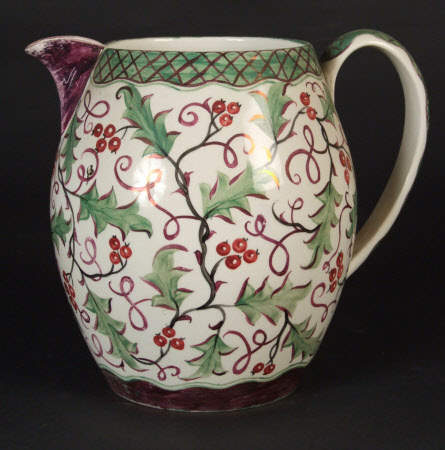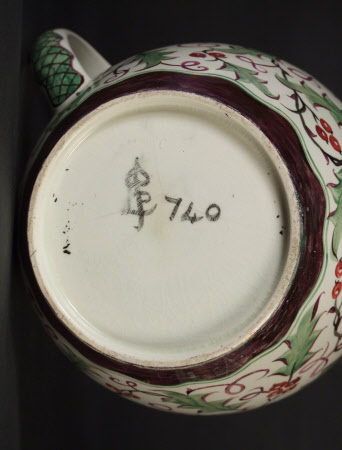Jug
Louise Powell (1882-1956)
Category
Ceramics
Date
1920 - 1930
Materials
Earthenware
Measurements
199 mm (H); 160 mm (W); 227 mm (D)
Place of origin
London
Order this imageCollection
Owletts, Kent
NT 1410891
Summary
Jug, pale coloured earthenware, barrel-shaped body narrowing to the rim with angular lip, inset foot rim, simple strap handle attached at the shoulder and lower body, decorated by Louise Powell in London, Josiah Wedgwood & Sons Ltd, Etruria, Stoke on Trent, ca 1920-30; decorated by hand with a free flowing design of stylised fruiting holly in red, green and black, with scrolls of purple lustre between, the spout with purple lustre, a band of lustre with wavy edge and line of green enamel at base, beneath the rim a pattern of lustre cross hatches against a green ground, the lower edge wavy with a plain green wavy line beneath, a similar pattern running along the vertical of the handle.
Full description
Ada Louise Powell (née Lessore) was a talented painter, calligrapher and embroiderer. She is best known for the intricate, hand-painted ceramics she produced as an independent artist working with pottery manufacturer Josiah Wedgwood & Sons. Powell was from a creative family and ceramics were in her blood. Her grandfather Emile Lessore trained at the Sèvres porcelain manufactory in France, before moving to England and joining Minton, later becoming a design consultant for Wedgwood. Her father, Jules, and her sister Elaine Thérèse also painted Wedgwood ceramics. Powell trained in calligraphy and illumination at the Central School of Arts and Crafts in London. An important early commission was the remarkable work she undertook to complete an unfinished illuminated manuscript translation of Virgil’s Aeneid by William Morris (1834–96). The expression, line control, rich level of detail and use of jewel-like colour that she learned through her training translated beautifully into ceramic painting. These qualities can be seen on the flowing foliage designs painted across the surface of this vase. Following her marriage to Alfred Powell, Louise began to focus on ceramics. From their studio in Red Lion Square, London, the Powells designed and decorated Wedgwood blanks (undecorated pots), which were sent back to the company factory in Etruria, Stoke-on-Trent, to be fired and sold, often through the London retailer and glassmakers James Powell & Sons. The Powells regularly visited Wedgwood, where they studied the historic pattern books and trained the factory’s decorators in hand-painting on earthenware (at the time, ceramics were decorated mostly by printing). The Powells’ relationship with Wedgwood lasted for 40 years and their work firmly re-established the company’s reputation for artistry and traditional craftsmanship. Many of the artists they nurtured, such as Millicent Taplin and Star Wedgwood, went on to enjoy long and distinguished careers in the Potteries.
Marks and inscriptions
Underside of base: LP / 740 (monogram for Louise Powell, painted in black enamel) 740 (painted in black enamel)
Makers and roles
Louise Powell (1882-1956), decorator Wedgwood, manufacturer
References
Good Workmanship with Happy Thought: the work of Alfred and Louise Powell, Cheltenham Art Gallery and Museum, 1992 Klarner, Rebecca ‘Ceramics as a canvas: Wedgwood blanks as an intersection between fine and decorative arts and the legacy of the Lessore family', Transactions of the English Ceramic Circle, Volume 30, pp. 83-96

